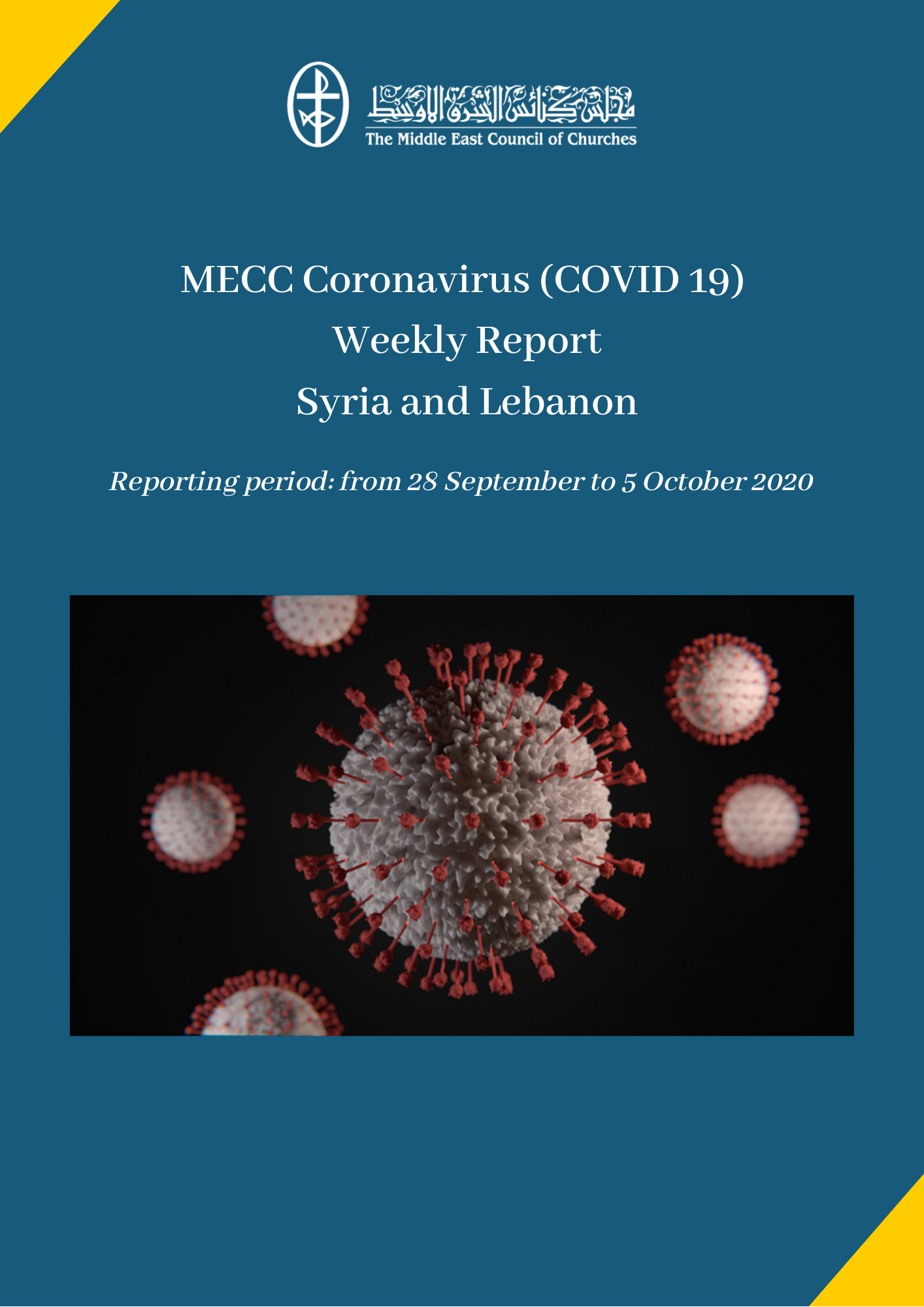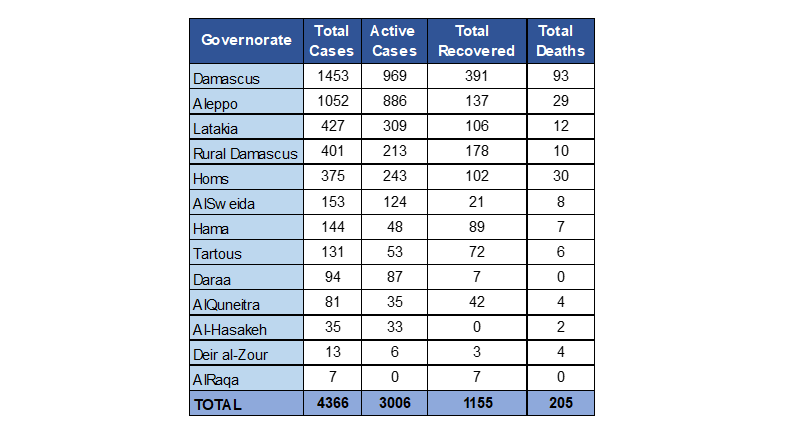MECC Coronavirus (COVID 19) Weekly Report
SYRIA: COVID-19
Humanitarian Update No. 28
Reporting period: from 28 September to 4 October 2020
Coronavirus cases: 4366 Active cases: 3066 Recovered: 1155 Deaths: 205 [1]
Highlights
Number of people confirmed by the Ministry of Health (MoH) to have COVID-19: 4366 (205 fatalities, 1155 recovered).
Of the cases announced by the MoH, 126 are reported to be healthcare workers, largely in Damascus.
As of 28 September, authorities in Northeast Syria(NES)have reported 1,557cases (1,174in Al-Hasakeh, 164 in Aleppo, 183in Ar-Raqqa, and 36in Deir-ez-Zor), including 62 fatalities and47 recoveries. Healthcare workers have also been affected with 92 reported cases. As is the case elsewhere, limited testing likely means significantly higher numbers exist.
Since the last report, further repatriation flights landed in Damascus, including from the United Arab Emirates (222), Libya (146) and Oman(197); to date, more than 5,000 nationals have been repatriated.
The Government of Syria (GoS) has announced that when international passenger flights resume on 1 October, there will be no further repatriation flights.
In NES, Local authorities also announced schools would reopen on 27 September.
To date, reports indicate that Ministry of Social Affairs and Labor (MoSAL) have disbursed one-time payments (SYP 100,000) to about 40,000 people.
An inter-agency socio-economic impact assessment of COVID-19 has been completed. Findings indicate a major economic downturn and significant social impacts, amplified by the ongoing financial crisis in Lebanon. As a result of the multiple crises (including but not solely COVID-19), it is estimated 200,000-300,000 jobs were permanently lost. The informal sector and businesses have been heavily impacted, with 15 per cent of small and medium sized business reporting permanent closure. In addition, remittances –on which many families heavily rely –are estimated to have reduced up to 50 percent.
Preparedness and response
During the reporting period, new Risk Communication and Community Engagement (RCCE)-supported radio and television spots highlighting key preventive measures, including messages specifically targeting children were broadcast on ten public and private stations.
WHO supported one further workshop for media professionals aimed at raising COVID-19 awareness and combating rumors. WHO also continues technical support for the MoH COVID-19 Dynamic Infographic Dashboard for Syria, in Arabic and English.
UNFPA reached 7,874 people on awareness raising including through mobile teams, in clinics, and in women and girls’ safe spaces, and distributed relevant IEC materials.
During the reporting period, WHO supported a workshop for health workers on updated findings and recommended standards in the context of COVID-19.
With the reopening of schools, UNICEF within the reporting period focused support on awareness raising in schools in 14 governorates, including distribution of 110,671 IEC materials promoting handwashing and physical distancing.
OXFAM reported training of trainers in Rural Damascus and Aleppo and is preparing rollout of Information, Education and Communication (IEC) materials specifically targeting returnee communities. In Aleppo Governorate, Al-Ihsan worked to raise awareness through mobile teams, home visits and at their charity centers.
In NES, During the reporting period, in Al-Hol camp, a community rapid assessment exercise commenced, led by UNICEF with WHO support WASH, with 2,500 questionnaires collected so far. in addition to ongoing support to 55 community volunteers working with the Risk Communication and Community Engagement (RCCE) working group. In the reporting period, the volunteers reached 2,400 families with tent-to-tent visits.
WHO supported printing of posters with the updated case definition to distribute to health facilities. In addition, suspected cases has also been included as a priority in the Early Warning, Alert and Response System (EWARS) system.
During the reporting period, more than 5,400 suspected COVID19 cases and contacts were investigated within 24 hours of an alert being received.
To enhance surveillance efforts, WHO is working to expand active surveillance beyond the existing 125 hospitals to all primary healthcare facilities.
As of 28 September, approximately 25,091 samples had been collected from thirteen governorates since mid-March, including 123 samples from Al-Hasakeh,55 from Deir-ez-Zor and seven from Ar-Raqqa.
In September, with WHO support, a new laboratory to test for COVID-19 came online in Rural Damascus.
Within the reporting period, WHO delivered a further 30,000 face shields to be prioritized for hospitals responding to COVID-19.
In NES, a UNICEF and WHO shipment of more than 15 000 PPE items arrived in Qamishli to be distributed in camps and informal settlements respectively.
During the reporting period, UNICEF continued operation and maintenance of WASH infrastructure (including the provision of sodium hypochlorite for water disinfection) across the country. To date, UNICEF has supported light rehabilitation of WASH systems in 15 quarantine and isolation facilities.
Triangle Génération Humanitaire (TGH) with SARC distributed 1,039 hygiene kits in Rural Damascus, alongside hygiene promotion sessions. Adventist Development and Relief Agency (ADRA) supported delivery of 3,605 COVID-19 sanitation kits in Idleb and Hama. UNFPA further distributed 2,500 protection dignity kits in Quneitra and sanitary napkins in Homs, in addition to hygiene kits including PPE and disinfectants to supported facilities.
UN Habitat continues to implement solid waste management projects in Homs and Hama, and in the reporting period conducted two hygiene awareness sessions. UNRWA continued to support essential WASH services to Palestine refugees in ten accessible camps (and three informal camps) including maintenance of the existing sewerage and water supply networks and solid waste management. Sterilization of installations also continued, as did distribution of PPE to 125 sanitation laborers as a priority.
In the reporting period, WHO supported training of100healthcare workers on case management in Rural Damascus, Quneitra and Tartous including on immediate life support and ventilator management. In addition, WHO continued training for midwives, supporting an additional capacity building training for 30 midwives in Lattakia.
Within the reporting period, UNFPA reported challenges importing certain medical supplies critical to the COVID-19 response, owing largely to exchange rate volatility and banking challenges; in addition, the recent severe shortages of fuel was also reported by a wide range of actors, including UNFPA, as limiting field missions and adversely impacting transportation costs.[2]
Lebanon: COVID-19
Humanitarian Update No. 25
Reporting period: from 29 September to 5 October 2020
Coronavirus cases: 44,482 Deaths: 406 Recovered: 19,782
Highlights
During this reporting period, Lebanon registered an average of 1242 new cases per day.
Due to increase in COVID-19 cases in Lebanon, the Ministry of Interior announced that 111 towns and villages will be placed in lockdown.
Lebanon ranked 65th globally in the number of COVID-19 cases and 81st in the number of deaths from the virus.[3]
Despite the dangerous increase of new cases per day and the fact that there are barely any hospital beds available for corona patients, Petra Khoury, the caretaker advisor for health affairs, considered that "the option to close the country is not available, because it means an end to the economic sector.
Updated Measures
The Ministry of Interior and Municipalities issued Decision No. 1205 on 10/2/2020 related to the closure of some villages and towns due to their high number of Coronavirus cases, as the decision kept on working at the time of preventing exit and entering the streets and roads between the first hour after midnight until the hour Six o'clock in the morning. The decision also included the closure of 111 towns in various Lebanese regions based on an analysis of the epidemiological situation in them for a full week, starting from Sunday 10/4/2020 until 10/12/2020 with specifying exceptions and the implementation mechanism for implementing the decision in cooperation between governors, municipalities and all security agencies.
Preparedness and response
The Minister of Public Health in the caretaker government, Dr. Hamad Hassan, chaired a meeting between the Ministry of Public Health, and hospital representatives to standardize PCR tariffs.
Medical teams were dispatched from the Ministry of Public Health to complete the necessary surveys (PCR and Rapid Tests) in the 111 cities and towns that have begun to be closed and isolated, with the aim of uncovering the epidemiological reality in them and striving to limit the spread of the pandemic.
The Ministry of Public Health signed an agreement between the Lebanese University and the General Directorate of Civil Aviation at the Ministry of Public Works under which the Lebanese University would conduct PCR checks for arrivals at the airport.
[1] Microsoft power MOH, 27 Sep
[2] WHO – OCHA, SYRIA : COVID-19 Humanitarian Update No. 19, As of 29 September2020
[3] Arab News, Sept 2, 2020, https://www.arabnews.com/node/1743226/middle-east


